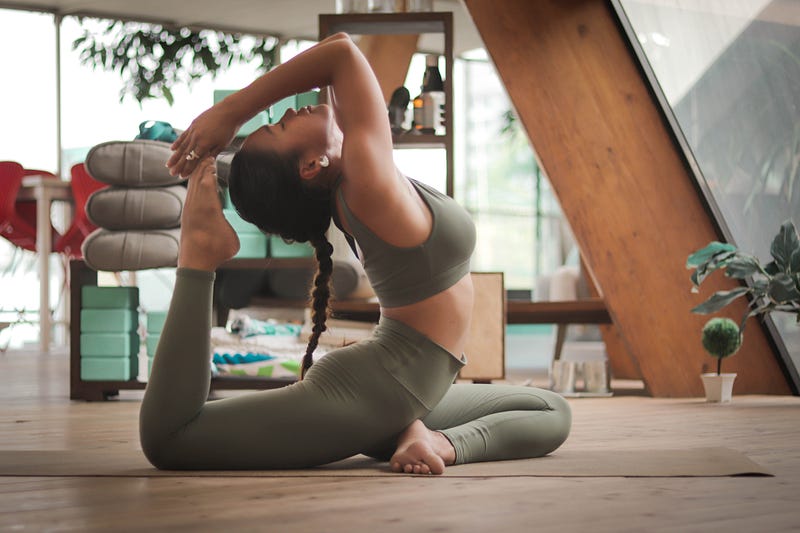How to move your body when your brain won’t cooperate
How to move your body when your brain won’t cooperate

The mental health benefits of moving your body are considerable, even though the barriers to entry can feel high.
Six days out of the week, at roughly 2 pm, I exercise. It’s my midday pick-me-up (as opposed to having another cup of coffee), helping me catch my second wind and finish out the day. How intense it depends on how I’m feeling. It could be a Peloton class or a heavy weight-lifting session. Or it could be a more restorative practice such as yoga or a long walk.
It seems like a simple enough endeavor, baked into my schedule, and ready for me to execute. There are many days, though, when I just don’t want to. I could be sitting in my gym clothes, with my bag packed and by the door, willing myself to get up and go move my body. These are the moments when I step back and assess if I should push myself, do something lighter than planned, or consider it a rest day and watch Rick and Morty reruns.
This is a feeling most of us know well. There are days when you have the motivation, others when you have to muster up your willpower to get moving, and some when you decide to just take the day off. But the movement, and resolving to do something even when you don’t feel up to it, don’t need to be about getting fit or hitting a personal record in the gym.
The best benefits of being active in some way are often the ones we don’t see touted on Instagram like having more energy during the day, building strength, boosting brain health, and other mental health benefits. Movement provides nearly everyone and everybody with these benefits no “perfect” aesthetic necessary. And while someone who is navigating a serious bout of depression or anxiety likely won’t have the same intrinsic motivation capacity as someone whose mental health is stable, everyone benefits from moving in some way.
Remind yourself how good it feels to move your body, and reframe what’s considered movement
The Department of Health and Human Services recommends getting at least 150 minutes of moderate aerobic activity or 75 minutes of vigorous aerobic activity each week, plus two days of strength training.
This doesn’t mean you need to visit your gym each day and push heavy weights or take a HIIT class. There’s a difference between exercise and physical activity. The former refers to structured activity in pursuit of a fitness goal, while the latter can be anything that requires you to move — including going on a walk, taking a virtual yoga class, dancing around your apartment, playing with your kids or pets, or some light stretching. On those days when you don’t feel up to your exercise routine, taking it easier than usual can still be a way to hit the recommended physical activity benchmarks.
We feel different every day due to sleep quality, stress, work, family obligations, and our mental health. Saving the tough workouts for the days you feel amazing, and modifying the days you don’t, allows you to take better care of your body in the long run. Striving for perfection is a sure way to burn out. It’s okay to deviate from the plan to meet yourself where you are and figure out why you don’t feel up to your usual.
Find an accountability buddy
Having friends who support you in moving your body can be the deciding factor between getting some steps in for the day or crashing on the couch, according to Sami Yli-Piipari, a physical activity specialist at the University of Georgia. Making physical activity a group endeavor can foster a sense of community and make you feel like others are on your side — a powerful motivator. “Humans need to be autonomous. They have a need to be competent in what they are doing, but also they need to feel like a relationship is there,” he explained.
Plus, it’s harder to opt-out of a pre-planned activity if friends or a trainer are waiting on you before class. Yli-Piipari also noted that less straightforward things, like scheduling an Uber in advance to pick you up for the gym, can help.
Create an environment that promotes sustainable movement
Our environments can promote or hinder our well-being — a complex reality influenced by someone’s various privileges and disadvantages — and it has a direct influence on how motivated we are to get something done. Taking your workout clothes to work, packing your gym bag the night before, laying out workout clothes in advance, or placing them on a chair you walk by frequently are just a few tips the experts I spoke to offered for building an environment that promotes movement.
It’s imperative to take stock of how you can fit bouts of movement into your day. Maybe it’s with a standing desk or walking around your room every hour.
For others, scheduling physical activity in a digital calendar or planner the same way you’d note a doctor’s appointment is effective. For those of us who love crossing things off a list, writing down exercises as if it’s a task helps too.
But it’s also vital to be realistic about when it happens. If you’re not a morning person, don’t schedule morning workouts. If your evenings are spent wrangling family obligations or you want to go out with your friends, then maybe a lunch hour session is best.
And if an hour block isn’t feasible, Heinrich suggests breaking it up into smaller chunks, which may work best for those with rigid or unpredictable schedules. Parents can also squeeze in workouts by joining their kids in running around on the playground, or doing a circuit as they’re watching their kids play. (A big selling point for at-home workouts is the fact that you can watch your children, take a meeting, or cook a meal in the oven during an exercise session.)
“Every minute of activity that you can do creates physiological and mental responses in your body,” she explained. “And typically, if someone is feeling exhausted, if you move your body, you will find that you feel better. And those aches and pains that you are starting to feel may just go away.”
Know the difference between feeling sluggish and needing to rest
Everyone I spoke with was clear that movement isn’t always the best solution to feeling blah. Perhaps the most important thing you can do is figure out the difference between needing to take a walk and needing to rest your body.
Tiredness can occur for several reasons. Sometimes you’ve been looking at your screen for too long, and you need an activity break. Other times, you could need a nap. If the fatigue is overwhelming or persistent, your body could be signaling that there’s an underlying medical issue that needs to be addressed. And of course, if you’re experiencing a fever, pain, or an injury, that’s a clear indication that you need to focus on getting better.

Comments
Post a Comment